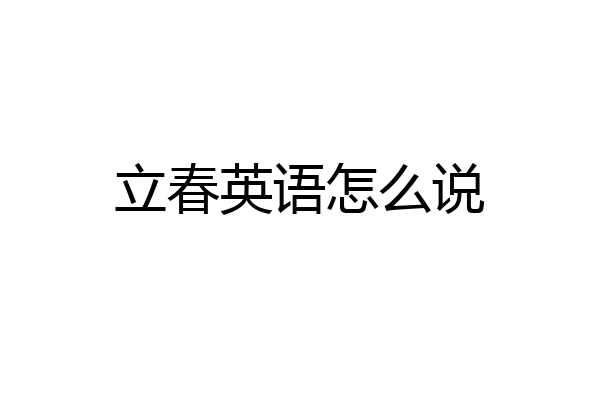
带嘴过日子
立春 the Beginning of Spring雨水 Rain Water 惊蜇 the Waking of Insects 春分 the Spring Equinox清明 Pure Brightness谷雨 Grain Rain立夏 the Beginning of Summer小满 Lesser Fullness of Grain芒种 Grain in Beard夏至 the Summer Solstice小暑 Lesser Heat大暑 Greater Heat立秋 the Beginning of Autumn处暑 the End of Heat白露 White Dew秋分 the Autumn Equinox寒露 Cold Dew霜降 Frost's Descent立冬 the Beginning of Winter小雪 Lesser Snow大雪 Greater Snow冬至 the Winter Solstice小寒 Lesser Cold大寒 Greater Cold


Diana~蜜桃
立春英语:Beginning of Spring
如果我们要向外国人介绍二十四节气,该怎么介绍呢?可以参考下联合国教科文组织官网上的介绍。早在2016年,我国申报的“二十四节气——中国人通过观察太阳周年运动而形成的时间知识体系及其实践”(The Twenty-Four Solar Terms: Chinese knowledge of time and practices developed through observation of the sun's annual motion)就已经入选联合国教科文组织《人类非物质文化遗产代表名录》了。是不是瞬间觉得这二十四个节气好高大上了!一起来看看联合国的官方介绍吧~The ancient Chinese divided the sun’s annual circular motion into 24 segments. Each segment was called a specific ‘Solar Term’.中国古人将太阳周年运动轨迹划分为24等份,每一等份为一个“节气”。The element of Twenty-Four Solar Terms originated in the Yellow River reaches of China. The criteria for its formulation were developed through the observation of changes of seasons, astronomy and other natural phenomena in this region and has been progressively applied nationwide.二十四节气形成于中国黄河流域,以观察该区域的季节、天文及其他自然现象的变化为基准,逐步为全国各地所采用。It starts from the Beginning of Spring and ends with the Greater Cold, moving in cycles. The element has been transmitted from generation to generation and used traditionally as a timeframe to direct production and daily routines. It remains of particular importance to farmers for guiding their practices.二十四节气始于立春,终于大寒,周而复始,是中国人世代相传的生产和日常生活的时间指南,对指导农民的农事活动尤为重要。Having been integrated into the Gregorian calendar, it is used widely by communities and shared by many ethnic groups in China. Some rituals and festivities in China are closely associated with the Solar Terms for example, the First Frost Festival of the Zhuang People and the Ritual for the Beginning of Spring in Jiuhua.二十四节气标注在阳历中,为中国民众广泛使用,并为多民族共享。中国的一些仪式和节庆也与二十四节气息息相关,如壮族霜降节、九华立春祭等。The terms may also be referenced in nursery rhymes, ballads and proverbs.二十四节气也被编入一些谣谚中。These various functions of the element have enhanced its viability as a form of intangible cultural heritage and sustain its contribution to the community’s cultural identity.

Rita泱泱
立春的英语为:Beginning of Spring。
立春,为二十四节气之首。立,是“开始”之意;春,代表着温暖、生长。二十四节气最初是依据“斗转星移”制定,当北斗七星的斗柄指向寅位时为立春。
现行是依据太阳黄经度数定节气,当太阳到达黄经315°时为立春,于每年公历2月3-5日交节。 干支纪元,以寅月为春正、立春为岁首,立春乃万物起始、一切更生之义也,意味着新的一个轮回已开启。在传统观念中,立春有吉祥的涵义。

zhang太太
立春英语:Beginning of Spring。
一、Beginning of Spring的发音,英音读[bɪˈɡɪnɪŋ ɒv sprɪŋ],美音读[bɪˈɡɪnɪŋ əv sprɪŋ]。立春;元春;春天开始了。
二、双语造句如下:
1、The beginning of spring: it means the beginning of spring.
立春:立春是指春季的开始。
2、Traditional Folk Arts and Crafts for Celebrating Beginning of Spring.
立春传统民俗工艺。
3、Magpies are clever birds. At the beginning of every spring it can predict the weather for the whole year.
喜鹊是一种很聪明的鸟,每年一开春,它就能预测出全年的气候。
4、The beginning of spring is a logical time to start a new year.
春天是一个开始的逻辑时间开始一个新的一年。
5、It's the end of Winter and the beginning of Spring.
这是结束的冬季和春季的开始。
6、It's just now the beginning of spring.
现在春天才刚开始。
优质英语培训问答知识库